List of ancient great powers
This article possibly contains original research. (October 2023) |

Recognized
The historical terms "Great Nation",
Ancient Western Asia
| Ancient Near East | |
|---|---|
|
| Assyria Mitanni Mycenaean Greece |
Sumer and Akkad
Sumer (or Šumer) was one of the early civilizations of the
Hurrians
| Hurrians |
|---|
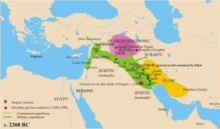 Akkad Elam |
The
By the Early Iron Age, the Hurrians had been assimilated with other peoples, except perhaps in the
Babylonia
The profound political, social, and cultural influence imposed upon the Near East by the civilization known as the Ancient Babylonian Empire was the most pervasive in this historical period. The city itself, Babylon, positioned itself as a center of pivotal historical developments for centuries. There were 3 major Babylonian Dynasties: Amorite, Kassite, and Chaldean.[10] This political entity was most predominate within the southern portion of Mesopotamia. It existed as an unremitting rival of the northern Assyrian Mesopotamians. Although it was assaulted and militarily overcome on several occasions, it did exist as a stalwart presence from the later 3rd millennium BC to the middle of the 6th century BC. After the fall of the Assyrian Empire in 612 BC,[11] the Babylonian Empire was the most powerful state in the ancient world. Its capital, Babylon, was beautifully adorned by King Nebuchadnezzar, who erected several famous buildings. Even after the Babylonian Empire had been overthrown by the Persian king Cyrus the Great in 539 BC,[12] the city itself remained an important cultural center. This period would be considered the zenith of Babylon's dominance in its two-and-a-half millennium history. Ancient Babylon was officially conquered by the Achaemenid Persian Empire in the late 6th century BC.
Assyria
| Neo-Assyrian Empire |
|---|
In early times, the term Assyria referred to a region on the Upper Tigris river, named for its original capital, the ancient city of Assur.[13] Later, as a nation and empire that came to control all of the Fertile Crescent, Egypt and much of Anatolia,[14] the term "Assyria proper" referred to roughly the northern half of Mesopotamia (the southern half being Babylonia), with Nineveh as its capital.[15] The Assyrian homeland was located near a mountainous region, extending along the Tigris as far as the high Gordiaean or Carduchian mountain range of Armenia, sometimes known as the "Mountains of Ashur". The Assyrian kings controlled a large kingdom at three different times in history. These are called the Old, Middle, and Neo-Assyrian kingdoms, or periods.[13] The most powerful and best-known nation of these periods is the Neo-Assyrian Empire, 934–609 BC.[16]
Under
Hittites
Hittite Empire
|
|---|
|
Lukka are to the west, with Mitanni to the southeast. |
The
The Hittites were also famous for their skill in building and using chariots, as the Battle of Kadesh demonstrated. The Hittites were pioneers of the Iron Age, manufacturing iron artifacts from as early as the 14th century BC, making them possibly even the first to do so. The Hittites passed much knowledge and lore from the Ancient Near East to the newly arrived Greeks in Europe.
Hittite prosperity was mostly dependent on control of the trade routes and metal sources. Because of the importance of northern Syria to the vital routes linking the Cilician Gates with Mesopotamia, defense of this area was crucial, and was soon put to the test by Egyptian expansion under Pharaoh Rameses II. The outcome of the Battle of Kadesh is uncertain, though it seems that the timely arrival of Egyptian reinforcements prevented total Hittite victory. The Egyptians forced the Hittites to take refuge in the fortress of Kadesh, but their own losses prevented them from sustaining a siege. This battle took place in the fifth year of Rameses II (c. 1274 BC by the most commonly used chronology).
Phoenicia
Ancient Phoenicia
|
|---|
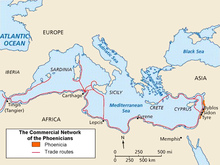 |
Carthaginian Empire
The Carthaginian Empire, also known as the Carthaginian Republic (alternatively "Carthaginian hegemony", or simply "Carthage") was the
Ancient Iran
Elam
| Elamite Empire |
|---|
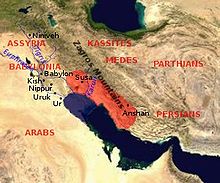 The approximate Bronze Age Elamite Empire extension of the Persian Gulf is shown. |
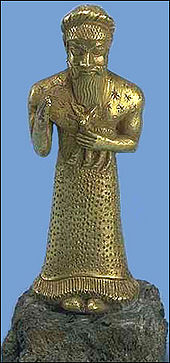
Elam was part of the early
Elamite culture played a crucial role in the Persian Empire, especially during the Achaemenid dynasty that succeeded it, when the Elamite language remained among those in official use. The Elamite language is generally treated as a language isolate. As such, the Elamite period is considered a starting point for the history of Iran.
Medes
Median Empire
|
|---|
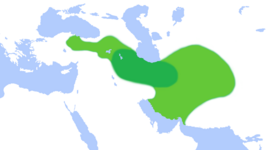 |
This article needs to be updated. The reason given is: More recent reassessment of the historical evidence, both archaeological and textual, has led modern scholars to question previous notions of the extent of the realm of the Medes and even its existence as a unified state. See Talk:Medes#Dated. (June 2020) |
The
Achaemenid Empire
- 550 BC–330 BC
| Achaemenid Empire |
|---|
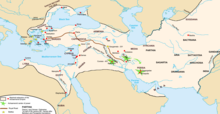 Outlying regions Achaemenid imperial region cities, battles, power centers |
The
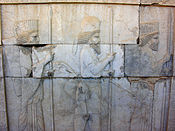
Encompassing approximately 5.5 million square kilometers at its height in 500 BC,[23][24] the Achaemenid Empire was territorially the largest empire of antiquity.[dubious ] In its time it had political power over neighboring countries, and had high cultural and economic achievements during its lengthy rule over a vast region from its picturesque capital at Persepolis.
Alexander the Great (Alexander III of Macedon) defeated the Persian armies at Granicus (334 BC), followed by Issus (333 BC), and lastly at Gaugamela (331 BC). Afterwards, he marched on Susa and Persepolis which surrendered in early 330 BC. From Persepolis, Alexander headed north to Pasargadae where he visited the tomb of Cyrus the Great.
Armenia
Great Armenia
- 331 BC–428 AD
| Kingdom of Armenia |
|---|
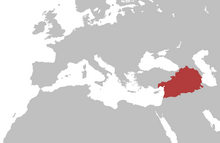 |
The Kingdom of Armenia was one of the first Armenian Empires. At the height of its power, the Empire spanned over many parts of countries, namely the modern-day countries of Turkey, Iran, Syria and Lebanon. The Kingdom of Armenia has three distinct dynasties - the Orontid dynasty, the Artaxiad dynasty, and the Arsacid dynasty of Armenia. During the reign of the Orontid dynasty, Armenia became independent from the Achaemenids. During the reign of the Artaxiad dynasty, Armenia has reached the peak of its power. During the reign of the Arsacid dynasty, Armenia became the first country in the world to adopt Christianity as an official religion.
In 387, the Kingdom of Armenia was split between the
Iran
Parthian Empire
| Parthian Empire |
|---|
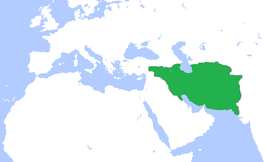 |
The
The Parthians largely adopted the art, architecture, religious beliefs, and royal insignia of their culturally heterogeneous empire, which encompassed Persian, Hellenistic, and regional cultures. For about the first half of its existence, the Arsacid court adopted elements of Greek culture, though it eventually saw a gradual revival of Iranian traditions. The Arsacid rulers were titled the 'King of Kings', as a claim to be the heirs to the Achaemenid Empire; indeed, they accepted many local kings as vassals where the Achaemenids would have had centrally appointed, albeit largely autonomous, satraps. The court did appoint a small number of satraps, largely outside Iran, but these satrapies were smaller and less powerful than the Achaemenid potentates. With the expansion of Arsacid power, the seat of central government shifted from Nisa, Turkmenistan to
Sasanian Empire
Sassanid Empire
|
|---|
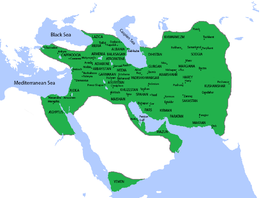 |
The
The empire constituted the last great Iranian Empire before the Muslim conquest and adoption of Islam. The climactic Byzantine–Sasanian War of 602–628 had drastically exhausted both the Byzantines as well as the Sassanids, laying the way open for an easy conquest. The Sassanids, heavily weakened, never mounted a truly effective resistance to the pressure applied by the initial Arab armies. Ctesiphon fell after a prolonged siege. Yazdegerd fled eastward from Ctesiphon, leaving behind him most of the Empire's vast treasury. The Arabs captured Ctesiphon shortly afterward, leaving the Sassanid government strapped for funds and acquiring a powerful financial resource for their own use. A number of Sassanid governors attempted to combine their forces to throw back the invaders, but the effort was crippled by the lack of a strong central authority, and the governors were defeated at the Battle of Nihawānd. The empire, with its military command structure non-existent, its non-noble troop levies decimated, its financial resources effectively destroyed, and the Asawaran knightly caste destroyed piecemeal, was utterly helpless in the face of the invaders. Upon hearing the defeat, Persian nobilities fled further inland to the eastern province of Khorasan.
United Kingdom of Israel
King David's rise to power over all the Israeli tribes and until the division of the kingdom in the days of his demise, the Kingdom of Israel ruled over vast areas (from the Sinai Peninsula to the Euphrates River) and of high commercial importance. In addition to the army that subordinated to the Kingdom of Israel many vassal kingdoms and other allies, the Kingdom of Israel united to the regional council was of high importance in this region at that time.
Ancient Africa
Ancient Egypt
| Ancient Egypt |
|---|
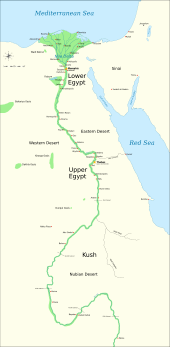 |
Ancient Egypt was one of the world's first civilizations, with its beginnings in the fertile Nile valley around 3150 BC.

It was one of the first nations to have a system of writing and large scale construction projects. However, as neighboring civilizations developed militaries capable of crossing Egypt's natural barriers, the Egyptian armies were not always able to repel them and so by 1000 BC Egyptian influence as an independent civilization waned.[26]
Early Dynastic Period
The Archaic or Early Dynastic Period of Egypt is the era immediately following the unification of Upper and Lower Egypt c. 3100 BC. It is generally taken to include the First and Second Dynasties, lasting from the end of the Naqada III archaeological period until about 2686 BC, or the beginning of the Old Kingdom.[27] With the First Dynasty, the capital moved from Thinis to Memphis with a unified Egypt ruled by an Egyptian god-king. Abydos remained the major holy land in the south. The hallmarks of ancient Egyptian civilization, such as art, architecture and many aspects of religion, took shape during the Early Dynastic period. During the Early Dynastic period, the pharaohs established the earliest Central Government in the world.
Old Kingdom
The Old Kingdom is the period spanning c. 2686–2181 BC. It is also known as the "Age of the Pyramids" or the "Age of the Pyramid Builders", as it encompasses the reigns of the great pyramid builders of the
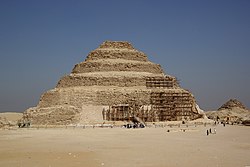
During the Old Kingdom, the pyramid building in ancient Egypt began during the
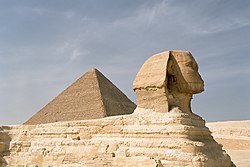
During the Fifth Dynasty the pyramid building declined in Egypt. The Pyramid Texts, the oldest ritual texts from ancient Egypt first appeared in the late fifth Dynasty.
Middle Kingdom
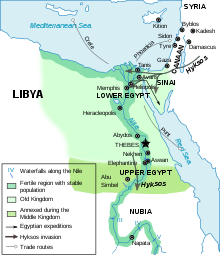
The Middle Kingdom of Egypt (also known as "The Period of Reunification") is the period in the history of ancient Egypt following a period of political division known as the First Intermediate Period. The Middle Kingdom lasted from around 2050 BC to around 1710 BC, stretching from the reunification of Egypt under the reign of Mentuhotep II of the Eleventh Dynasty to the end of the Twelfth Dynasty. The Eleventh Dynasty ruled from Thebes and the Twelfth Dynasty ruled from el-Lisht.
The middle kingdom reached its peak under the pharaohs Senusret III and Amenemhat III. Senusret III was a great pharaoh of the Twelfth Dynasty and is considered to be the greatest pharaoh in the middle kingdom. However, The reign of Amenemhat III was the height of Middle Kingdom economic prosperity. His reign is remarkable for the degree to which Egypt exploited its resources.
New Kingdom
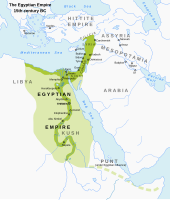
Core Regions
Territorial control
The
Third Intermediate Period
The Third Intermediate Period of Ancient Egypt began with the death of Pharaoh
The first Dynasty of the Ancient Egyptian
The country was firmly reunited by the Twenty-Second Dynasty founded by Shoshenq I in 945 BC (or 943 BC), who descended from Meshwesh immigrants, originally from Ancient Libya. Upon unifying Egypt, king Shoshenq I started campaigning in the Levante . This brought stability to the country for well over a century and made Egypt a superpower again, but after the reign of Osorkon II, particularly, the country had effectively split into two states, with Shoshenq III of the Twenty-Second Dynasty controlling Lower Egypt by 818 BC while Takelot II and his son Osorkon (the future Osorkon III) ruled Middle and Upper Egypt.
Late Period
The Late Period of ancient Egypt refers to the last flowering of native Egyptian rulers after the Third Intermediate Period beginning with the 26th Saite Dynasty founded by Psamtik I. The 26th Dynasty of Egypt managed to regain Egypt's power for a short time before the Achaemenid conquest of Egypt lad by Cambyses II in 525 BC.
However, the Egyptians managed to gain independence from the Persians during a rebellion led by the rebel Pharaoh Amyrtaeus around 404 B.C who established the Twenty-eighth Dynasty of Egypt. Egypt remained independent during the Twenty-ninth Dynasty and Thirtieth Dynasty until the Persians invaded it again in 343 B.C. During that time, the Egyptians managed to repel several attacks from the Achaemenid Empire. The most famous attack of them occurred in around 351 BC, when Artaxerxes III embarked on a campaign to recover Egypt, which had revolted under his father, Artaxerxes II. Levying a vast army, Artaxerxes marched into Egypt, and engaged Nectanebo II the founder of the Thirtieth Dynasty of Egypt. After a year of fighting the Egyptian Pharaoh, Nectanebo inflicted a crushing defeat on the Persians with the support of mercenaries led by the Greek generals Diophantus and Lamius.
The Late period of ancient Egypt ends when Alexander the Great took Egypt from the Persians without war around 332 B.C.
Legacy
The many achievements of the ancient Egyptians include the quarrying, surveying and construction techniques that facilitated the building of monumental pyramids, temples, and obelisks; a system of mathematics, a practical and effective system of medicine, irrigation systems and agricultural production techniques, the first known ships, Egyptian faience and glass technology, new forms of literature, and the earliest known peace treaty. Egypt left a lasting legacy. Its art and architecture were widely copied, and its antiquities carried off to far corners of the world. Its monumental ruins have inspired the imaginations of travellers and writers for centuries. A new-found respect for antiquities and excavations in the early modern period led to the scientific investigation of Egyptian civilization and a greater appreciation of its cultural legacy, for Egypt and the world.
Kerma
The Kerma culture was an early civilization which flourished from around 2500 BC to about 1600 BC in Nubia, present day Sudan, centered at Kerma. It seems to have been one of a number of Sudanese states during the Middle Kingdom period of Ancient Egypt. In its latest phase, lasting from about 1700–1500 BC, it absorbed the Sudanese kingdom of Sai and became a sizable, populous empire rivaling Egypt. Around 1500 BC, it was absorbed into the Egyptian Empire, but rebellions continued for centuries. By the 11th century BC, the more 'Egyptianized' Kingdom of Kush emerged, apparently from Kerma, and regained the region's independence from Egypt.[29]
Kush
| Kingdom of Kush |
|---|
 |
The Kingdom of Kush was the earliest of the Subsaharan states in Africa as well as the first to implement iron weapons. It was heavily influenced by Egyptian colonists, but in 1070 BC it became not only independent of Egypt but a fierce rival. It successfully fought off attempts by Egypt to reconquer it, and it began to extend influence over Upper Egypt. By the end of King Kashta's reign in 752 BC, Thebes was under Kushite control.
A slew of able successors took the rest of Egypt and reigned as the
The kingdom of Kush maintained its status as a regional power until its conquest by the
Macrobia
The Macrobians were an ancient people and kingdom situated in the Horn of Africa (Somalia) around the 1st millennium BC. According to Herodotus, the Macrobians practiced an elaborate form of embalming. This, in turn, suggested a knowledge on their part of anatomy and, at the very least, a grasp of the basics of chemistry. The Macrobians preserved the bodies of the dead by first extracting moisture from the corpses, then overlaying the bodies with a type of plaster, and finally decorating the exterior in vivid colors in order to imitate the deceased as realistically as possible. They then placed the body in a hollow crystal pillar, which they kept in their homes for a period of about a year.[30] Macrobia was also noted for its gold, which was so plentiful that the Macrobians shackled their prisoners in golden chains.[31]
The Ancient city-states located in northern
Kingdom of Aksum
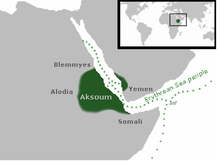
The
Ancient India
Several Indian empires including
Maurya Empire
This section needs additional citations for verification. (June 2020) |
| Maurya Empire |
|---|
|
Ashoka the Great |
The
The Empire was founded in 322 BC by
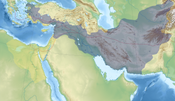
The Empire was divided into four provinces, which one of the four, look like a giant crescents. with the imperial capital at
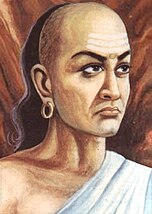
Historians theorize that the organization of the Empire was in line with the extensive bureaucracy described by
Chola Empire
| Chola Empire |
|---|
|
Rajendra Chola c. 1030 AD |
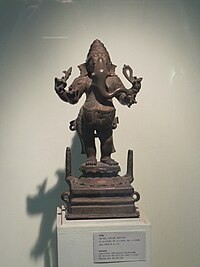
The
The heartland of the Cholas was the fertile valley of the
During the period 1010–1200, the Chola territories stretched from the islands of the
The Cholas left a lasting legacy. Their patronage of
Gupta Empire

In the 4th and 5th centuries, the
The high points of this cultural creativity are magnificent architectures, sculptures and paintings. The Gupta period produced scholars such as
Ancient China
Shang dynasty
The Shang dynasty (
Zhou dynasty
The Zhou dynasty (c. 1046–256 BC;
This period of Chinese history produced what many consider the zenith of Chinese bronze-ware making. The dynasty also spans the period in which the written script evolved into its modern form with the use of an archaic clerical script that emerged during the late Warring States period.
Qin dynasty
| Qin Dynasty |
|---|
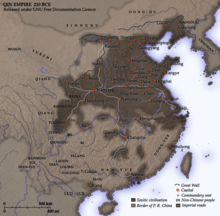 Qin region Outlying regions |
The Qin dynasty was preceded by the
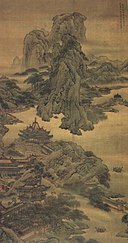
In 214 BC Qin Shihuang secured his boundaries to the north with a fraction (100,000 men) of his large army, and sent the majority (500,000 men) south to seize still more land. Prior to the events leading to Qin dominance over China, they had gained possession of much of Sichuan to the southwest. The Qin army was unfamiliar with the jungle terrain, and it was defeated by the southern tribes' guerrilla warfare tactics with over 100,000 men lost. However, in the defeat Qin was successful in building a canal to the south, which they used heavily for supplying and reinforcing their troops during their second attack to the south. Building on these gains, the Qin armies conquered the coastal lands surrounding Guangzhou, and took the provinces of Fuzhou and Guilin. They struck as far south as Hanoi. After these victories in the south, Qin Shihuang moved over 100,000 prisoners and exiles to colonize the newly conquered area. In terms of extending the boundaries of his empire, the First Emperor was extremely successful in the south.
Despite its military strength, the Qin dynasty did not last long. When the first emperor died in 210 BC, his son was placed on the throne by two of the previous emperor's advisers, in an attempt to influence and control the administration of the entire country through him. The advisors squabbled among themselves, however, which resulted in both their deaths and that of the second Qin emperor. Popular revolt broke out a few years later, and the weakened empire soon fell to a Chu lieutenant, who went on to found the Han dynasty. Despite its rapid end, the Qin dynasty influenced future Chinese regimes, particularly the Han, and the European name for China is derived from it.
Han dynasty
Han Dynasty
|
|---|
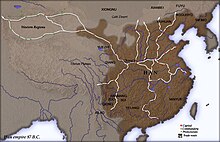 Han region Outlying regions |
The Han dynasty (202 BC – AD 220), lasting 400 years, is commonly considered within China to be one of the greatest periods in the history of China. At its height, the Han empire extended over a vast territory of 6 million km2 and housed a population of approximately 55 million. During this time period, China became a military, economic, and cultural powerhouse. The empire extended its political and cultural influence over Korea, Japan, Mongolia, Vietnam, and Central Asia before it finally collapsed under a combination of domestic and external pressures.
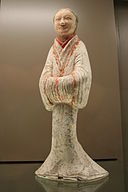
The Han Empire was divided into areas directly controlled by the central government, known as commanderies, and a number of semi-autonomous kingdoms. These kingdoms gradually lost all vestiges of their independence, particularly following the Rebellion of the Seven States. The Xiongnu, a nomadic confederation which dominated the eastern Eurasian Steppe, defeated the Han army in battle in 200 BC. Following the defeat, a political marriage alliance was negotiated in which the Han became the de facto inferior partner. When, despite the treaty, the Xiongnu continued to raid Han borders, Emperor Wu of Han (r. 141–87 BC) launched several military campaigns against them. The ultimate Han victory in these wars eventually forced the Xiongnu to accept vassal status as Han tributaries. These campaigns expanded Han sovereignty into the Tarim Basin of Central Asia and helped establish the vast trade network known as the Silk Road, which reached as far as the Mediterranean world. Han forces managed to divide the Xiongnu into two competing nations, the Southern and Northern Xiongnu, and forced the Northern Xiongnu across the Ili River. Despite these victories, the territories north of Han's borders were quickly overrun by the nomadic Xianbei confederation. The Han Dynasty was arguably one of the strongest's empires in the world during the reign of Emperor Wu, though was established as the largest.
Jin dynasty
The Jin dynasty (
Ancient Europe
Ancient Greece
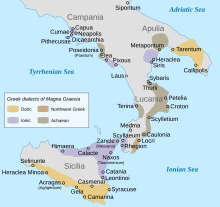
Ancient Greece is the civilization belonging to the period of Greek history lasting from the Archaic period of the 8th to 6th centuries BC to 146 BC and the Roman conquest of Greece after the Battle of Corinth. At the center of this time period is Classical Greece, which flourished during the 5th to 4th centuries BC, at first under Athenian leadership successfully repelling the military threat of Persian invasion. The
Athens, after a tyranny in the second half of the 6th century, established ancient Europe's first democracy as a radical solution to prevent the aristocracy from regaining power. A citizens' assembly (the Ecclesia), for the discussion of city policy, had existed since the reforms of Draco; all citizens were permitted to attend after the reforms of Solon, but the poorest citizens could not address the assembly or run for office. With the establishment of the democracy, the assembly became the de jure mechanism of government; all citizens had equal privileges in the assembly. However, non-citizens, foreigners living in Athens, slaves and women had no political rights at all. After the rise of the democracy in Athens, other city-states founded democracies. However, many retained more traditional forms of government. As so often in other matters, Sparta was a notable exception to the rest of Greece, ruled through the whole period by not one, but two hereditary monarchs. This was a form of diarchy.
Athens
Ancient Athens
|
|---|
 |

Sparta
Lacedaemon
|
|---|
 |
This section needs additional citations for verification. (June 2020) |
Following the victories in the Messenian Wars (631 BC), Sparta's reputation as a land-fighting force was unequaled.
In later Classical times, Sparta along with
Sparta was, above all, a militarist state, and emphasis on military fitness began virtually at birth.
Macedonia
Macedon
|
|---|
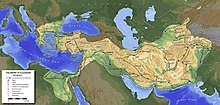 |
The

Philip's son, Alexander the Great, managed to briefly extend Macedonian power not only over the central Greek city-states, but also to the Persian empire, including Egypt and lands as far east as the fringes of India. Alexander's adoption of the styles of government of the conquered territories was accompanied by the spread of Greek culture and learning through his vast empire. Although the empire fractured into multiple Hellenic regimes shortly after his death, his conquests left a lasting legacy, not least in the new Greek-speaking cities founded across Persia's western territories, heralding the Hellenistic period. In the partition of Alexander's empire among the Diadochi, Macedonia fell to the Antipatrid dynasty, which was overthrown by the Antigonid dynasty after only a few years.
Hellenistic states
| ) |
Alexander had made no special preparations for his succession in his newly founded empire and the Apocrypha of his death state that on his death-bed he willed it to those that performed actions well and powerfully. The result was the wars of the Diadochi between his generals (the Diadochi, or 'Successors'), which lasted for forty years before a more-or-less stable arrangement was established, consisting of four major domains:
- The Macedonand central Greece;
- The Ptolemaic dynasty in Egypt based at Alexandria;
- The Seleucid dynasty in Syria and Mesopotamia based at Antioch;
- The .
A further two kingdoms later emerged, the so-called
Ancient Rome and the Roman Empire
| Roman Empire |
|---|
 |
Roman expansion began long before the state was transformed into a de facto monarchy and reached its zenith under emperor Trajan with the conquest of Mesopotamia and Armenia from 113 to 117.[52] The period of the "Five Good Emperors" saw a successions of peaceful years and the Empire was prosperous. Each emperor of this period was adopted by his predecessor. The Nerva–Antonine dynasty was a dynasty of seven consecutive Roman Emperors who ruled over the Roman Empire from 96 to 192. These Emperors are Nerva, Trajan, Hadrian, Antoninus Pius, Marcus Aurelius, Lucius Verus, and Commodus.
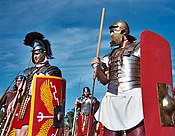
The last two of the "
At its territorial peak in the year 117, the Roman Empire controlled approximately 5,000,000 km2 (1,900,000 sq mi) of land surface.[53][48] After Trajans reign the Empire continued to grow stronger until the reign of Marcus Aurelius.[54] After the death of Marcus Aurelius his son, Commodus would take power. The reign of Commodus marked the beginning of the decline of the Roman Empire . Ancient Rome's influence upon the culture, law, technology, arts, language, religion, government, military, and architecture of Western civilization continues to this day even outside latin countries . It would fall to Odoacer in 476, but its eastern half will still be alive until it fell in 1453.[55]
Thracian States
The
The Odrysian kingdom was founded by king
The
By the middle of the 4th century there existed a Getic kingdom that was to thrive for a century.[62] The Getic capital was Helis, which has been identified with the archaeological site of Sboryanovo, which was founded in the 330s[63] or early 320s[61] and housed around 10.000 inhabitants.[64] It seems that the Getae also became active in Muntenia north of the Danube,[65][66] a region that would come to constitute a part of the "Dacia" of imperial Roman historiography.[67] The first Getic king to appear in the sources was Cothelas, who married his daughter Meda to Philip II,[61] thus concluding an alliance between the two states.[68] This probably happened during[69] or shortly after Philip's conquest of the Odrysians.[70] The kingdom survived two wars with Lysimachus[71] and the Celtic invasion in around 280, but eventually disintegrated a few decades later.[72] Helis/Sboryanovo was completely destroyed by an earthquake in the middle of the 3rd century.[64]
With Alexander's absence in Asia, the Strategoi of
The
The Thracian kingdom, also known as the
Seleucid Empire
| Seleucid Empire |
|---|
 |
The Seleucid Empire was a
Seleucid expansion into Greece was abruptly halted after decisive defeats at the hands of the Roman army.[84] Much of the eastern part of the empire was conquered by the Parthians under Mithridates I of Parthia in the mid-2nd century BC,[85] yet the Seleucid kings continued to rule a rump state from Syria until the invasion by Armenian king Tigranes the Great[82]and their ultimate overthrow by the Roman general Pompey.[86]
Ptolemaic Empire
Ptolemaic empire
|
|---|
 |
This section needs additional citations for verification. (June 2020) |
The
Ptolemy, one of the seven somatophylakes (bodyguards) who served as Alexander the Great's generals and deputies, was appointed satrap of Egypt after Alexander's death in 323 BC. In 305 BC, he declared himself King Ptolemy I, later known as "Soter" (saviour). The Egyptians soon accepted the Ptolemies as the successors to the pharaohs of independent Egypt. Ptolemy's family ruled Egypt until the Roman conquest of 30 BC. All the male rulers of the dynasty took the name Ptolemy.
Ptolemaic Egypt began when Ptolemy I Soter declared himself Pharaoh of Egypt in 305 BC and ended with the death of queen Cleopatra VII of Egypt and the Roman conquest in 30 BC. The Ptolemaic Kingdom was a powerful Hellenistic state, extending from southern Syria in the east, to Cyrene to the west, and south to the frontier with Nubia. Alexandria became the capital city and a center of Greek culture and trade. To gain recognition by the native Egyptian populace, they named themselves as the successors to the Pharaohs. The later Ptolemies took on Egyptian traditions, had themselves portrayed on public monuments in Egyptian style and dress, and participated in Egyptian religious life. Hellenistic culture continued to thrive in Egypt well after the Muslim conquest. The Ptolemies faced rebellions of native Egyptians often caused by an unwanted regime and were involved in foreign and civil wars that led to the decline of the kingdom and its annexation by Rome.
Ancient Eurasian Steppe
Scythia
Ancient Greeks gave the name Scythia (or Great Scythia) to all the lands north-east of Europe and the northern coast of the Black Sea. According to Oxford University author's Samuel Arrowsmith, B Fellowes and Luke Graves Hansard in their 1832 book A Grammar of Ancient Geography, Scythia had two parts, Scythia Intra Imaum and Scythia Extra Imaum[91] both covering a combined area of 1,129,000 mi2 or 2,924,096 km2.[92]
The Scythians – the Greeks' name for this nomadic people – inhabited Scythia from at least the 11th century BC to the 2nd century AD.[93] Its location and extent varied over time but usually extended farther to the west than is indicated on the map opposite.[94]
Sarmatia
The Sarmatians (Latin: Sarmatæ or
Originating in
Xiongnu
| Xiongnu |
|---|
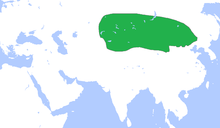 Xiongnu Region Outlying regions |
Xiongnu (Hsiung nu) was a
The Great Wall of China had been constructed to protect Chinese towns from the Xiongnu attacks. While the Chinese were trying to bring the Xiongnu under control, something of high significance happened: cross-cultural encounters. A large variety of people (such as traders, ambassadors, hostages, parents in cross-cultural marriages, etc.) served as helpers that passed on ideas, values, and techniques across cultural boundary lines. These encounters helped cultures learn from other cultures. The Xiongnu Empire disintegrated into two parts during the 1st century; eventually the Xiongnu fell due to their defeat in the Han–Xiongnu War.
Huns
| Hunnic Empire |
|---|
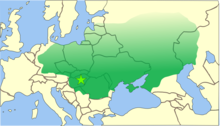 Attila's imperial capital (approximate) Attila's empire (approximate) Non-Hunnic Regions |
Huns were nomadic people who were known for their hordes of
The death of Rugila in 434 left the sons of his brother Mundzuk, Attila and Bleda, in control of the united Hun tribes.
During Attila the Hun's rule, he was one of the most fearsome enemies of the Western and Eastern Roman Empire. He invaded the Balkans twice and marched through Gaul (modern France) as far as Orléans before being defeated at the
See also
- General topics
- History of warfare
- Political science
- Power in international relations, Expansionism
- General Lists
- List of largest empires, List of transcontinental countries, List of former transcontinental countries
References
- ^ Webster, Charles K, Sir (ed), British Diplomacy 1813–1815: Selected Documents Dealing with the Reconciliation of Europe, G Bell (1931), p307.
- ^ Edward Sylvester Ellis, Charles F. Horne (1906). The story of the greatest nations: from the dawn of history to the twentieth century : a comprehensive history founded upon the leading authorities, including a complete chronology of the world and a pronouncing vocabulary of each nation, Volume 1. F. R. Niglutsch.
- ^ In Powell, T. (1888). Illustrated home book of the world's great nations: Being a geographical, historical and pictorial encyclopedia. Chicago: People's Pub. Co.
- ^ Yonge, C. M. (1882). A pictorial history of the world's great nations: From the earliest dates to the present time. New York: S. Hess.
- ^ Harrison, T., & J. Paul Getty Museum. (2009). The great empires of the ancient world. Los Angeles, Calif: J. Paul Getty Museum.
- ^ a b c "Who Were the Ancient Sumerians?". Discover Magazine. Retrieved 2022-01-26.
- ^ "The Sumerians and Mesopotamia (article)". Khan Academy. Retrieved 2022-01-26.
- ^ "Sumerians". World History Encyclopedia. Retrieved 2022-01-26.
- ^ a b "Hurrian | people | Britannica". www.britannica.com. Retrieved 2022-05-12.
- ^ "Beautiful Babylon: Jewel of the Ancient World". education.nationalgeographic.org. Retrieved 2023-05-10.
- ^ "Battle of Nineveh | Summary | Britannica". www.britannica.com. Retrieved 2023-05-10.
- ^ "Cyrus the Great - Livius". www.livius.org. Retrieved 2023-05-10.
- ^ a b Mark, Joshua J. "Assyria". World History Encyclopedia. Retrieved 2023-05-10.
- ^ "Assyrian Empire". education.nationalgeographic.org. Retrieved 2023-05-10.
- ^ "Assyria: Nineveh". The British Museum. Retrieved 2023-05-10.
- ^ Mark, Joshua J. "Neo-Assyrian Empire". World History Encyclopedia. Retrieved 2023-05-10.
- ^ "Shalmaneser III°". www.jewishvirtuallibrary.org. Retrieved 2023-05-10.
- ^ "Who was Ashurbanipal?". The British Museum. Retrieved 2023-05-10.
- ^ "Paradise on earth: the gardens of Ashurbanipal". The British Museum. Retrieved 2023-05-10.
- ^ "Timeline of Carthaginian History". Retrieved 5 October 2014.
- ISBN 978-0-8018-5130-8.
- ISBN 978-0-520-22614-2. Retrieved 11 February 2013.
- JSTOR 1170959.
- ISSN 1076-156X. Retrieved 2020-06-24.
- ^ "Arsacid dynasty | ancient Iranian dynasty | Britannica". www.britannica.com. Retrieved 2022-05-12.
- ^ "Math in Ancient Egypt". Archived from the original on 6 October 2014. Retrieved 5 October 2014.
- ISBN 0-19-815034-2.
- ^ "Old Kingdom of Egypt". World History Encyclopedia. Retrieved 2017-12-04.
- ^ Kerma culture
- ^ Society of Arts (Great Britain), Journal of the Society of Arts, Volume 26, (The Society: 1878), pp.912–913.
- ^ John Kitto, James Taylor, The popular cyclopædia of Biblical literature: condensed from the larger work, (Gould and Lincoln: 1856), p.302.
- ^ "Ancient India - Chandragupta Maurya". Retrieved 5 October 2014.
- ^ "The Last Years of Cholas: The decline and fall of a dynasty". Archived from the original on 20 January 2010. Retrieved 5 October 2014.
- K.A. Nilakanta Sastri, A History of South India, p 5
- K.A. Nilakanta Sastri, A History of South India, p 157
- ^ Kulke and Rothermund, p 115
- ^ a b c Keay, p 215
- K.A. Nilakanta Sastri, A History of South India, p 158
- ^ Majumdar, p 407
- K.A. Nilakanta Sastri, The CōĻas, pp 211–220
- ^ Meyer, p 73
- K.A. Nilakanta Sastri, A History of South India, p 192
- K.A. Nilakanta Sastri, A History of South India, p 195
- K.A. Nilakanta Sastri, A History of South India, p 196
- ^ Vasudevan, pp 20–22
- ^ Keay, pp 217–218
- ISSN 0049-089X. Retrieved 2020-06-24.
- ^ ISSN 1076-156X. Retrieved 2020-06-24.
- ^ The Macedonian Empire: the era of warfare under Philip II and Alexander the Great, 359–323 BC. - James R.
- ^ "A Historical Commentary on Thucydides" - David Cartwright, p. 176
- ^ Britannica ed. 2006, "Sparta"
- ISBN 978-3865392930.
- JSTOR 1170959.
- ISBN 2-221-05734-1.
- ISBN 978-0307700766.
- ^ Strobel 2019, p. 132, note 6.
- ^ Delev 2000, p. 399.
- ^ Archibald 1998, p. 6.
- ^ Delev 2000, pp. 393–394.
- ^ a b Archibald 1998, p. 225.
- ^ a b c d Stoyanov 2015a, p. 254.
- ^ Stoyanov 2015b, p. 430.
- ^ Delev 2000, p. 396.
- ^ a b Stoyanov 2015a, p. 255.
- ^ Delev 2000, pp. 395–396, 399.
- ^ Strobel 2019, pp. 149–150.
- ^ Strobel 2019, pp. 136–143.
- ^ Archibald 1998, p. 237.
- ^ Delev 2000, p. 395.
- ^ Worthington 2014, p. 76.
- ^ Delev 2000, pp. 386–392.
- ^ Delev 2015b, p. 63.
- ^ Lund 1992, p. 20.
- ^ Delev 2015a, pp. 53–54.
- ^ a b Delev 2018, p. 192.
- ^ Delev 2015a, p. 53.
- ^ Lund 1992, p. 22.
- ^ Lund 1992, pp. 23–24.
- ^ a b Delev 2015a, p. 54.
- ^ Archibald 1998, p. 316.
- ^ Sobotkova 2013, pp. 136–137.
- ^ a b c "Seleucid empire | History, Achievements, & Facts | Britannica". www.britannica.com. 2023-05-10. Retrieved 2023-06-02.
- ^ Art, Authors: Department of Ancient Near Eastern. "The Seleucid Empire (323–64 B.C.) | Essay | The Metropolitan Museum of Art | Heilbrunn Timeline of Art History". The Met’s Heilbrunn Timeline of Art History. Retrieved 2023-06-02.
- ^ Jasiński, Jakub. "Seleucid war with Antiochus III (192-190 BCE) « IMPERIUM ROMANUM". Retrieved 2023-06-02.
- ^ "The Seleucids, Parthians and Sassanids". VOICES FOR IRAQ. Retrieved 2023-06-02.
- ^ Mark, Joshua J. "Seleucid Empire". World History Encyclopedia. Retrieved 2023-06-02.
- ^ Cleopatra: A Sourcebook (Oklahoma Series in Classical Culture) by Prudence J. Jones (Author) page14 (cf., "They were members of the Ptolemaic dynasty of Macedonian Greeks, who ruled Egypt after the death of its conqueror, Alexander the Great.")
- ^ Women in Hellenistic Egypt By Sarah B. Pomeroy page 16 "while Ptolemaic Egypt was a monarchy with a Greek ruling class."
- ^ the Oxford Encyclopedia of Ancient Egypt. ", Cleopatra VII was born to Ptolemy XII Auletes (80–57 BC, ruled 55–51 BC) and Cleopatra, both parents being Macedonian Greeks.
- ^ Encyclopedia of the Archaeology of Ancient Egypt by Kathryn Bard. page 488. (cf., "Ptolemaic kings were still crowned at Memphis and the city was popularly regarded as the Egyptian rival to Alexandria, founded by the Macedonian Greeks.") Page 687. (cf., "During the Ptolemaic period, when Egypt was governed by rulers of Greek descent…")
- ^ Arrowsmith, Fellowes, Graves Hansard, S, B & L (3 Apr 2006). A Grammar of Ancient Geography: Compiled for the Use of King's College School. Oxford University: S. Arrowsmith, and B. Fellowes, 1832. p. 14. Retrieved 20 August 2014.
{{cite book}}: CS1 maint: multiple names: authors list (link) - ^ Arrowsmith, Fellowes, Graves Hansard, S, B & L (3 Apr 2006). A Grammar of Ancient Geography: Compiled for the Use of King's College School. Oxford University: S. Arrowsmith, and B. Fellowes, 1832. p. 15. Retrieved 20 August 2014.
{{cite book}}: CS1 maint: multiple names: authors list (link) - ^ Lessman, Thomas. "World History Maps". 2004. Thomas Lessman. Archived from the original on 8 December 2013. Retrieved 23 October 2013.
- ISBN 0-674-01130-9 ".....extending from the Black Sea in a northerly direction towards Ocean." In Boccaccio's time the Baltic Seawas known also as Oceanus Sarmaticus.
- ^ J.Harmatta: "Scythians" in UNESCO Collection of History of Humanity – Volume III: From the Seventh Century BC to the Seventh Century AD. Routledge/UNESCO. 1996. pg. 182
- ^ (2007). Encyclopædia Britannica, s.v. "Sarmatian". Retrieved May 20, 2007, from [Encyclopædia Britannica Online: http://www.britannica.com/eb/article-9065786]
- ^ Encyclopædia Britannica Online. Retrieved 31 December 2014.
- Aietes of Colchis(modern Georgia).
- ^ Arrowsmith, Fellowes, Hansard, A, B & G L (1832). A Grammar of Ancient Geography,: Compiled for the Use of King's College School (3 April 2006 ed.). Hansard London. p. 9. Retrieved 20 August 2014.
{{cite book}}: CS1 maint: multiple names: authors list (link) - ^ Arrowsmith, Fellowes, Hansard, A, B & G L (1832). A Grammar of Ancient Geography,: Compiled for the Use of King's College School (3 April 2006 ed.). Hansard London. p. 15. Retrieved 20 August 2014.
{{cite book}}: CS1 maint: multiple names: authors list (link) - ^ Migrations of peoples, although not strictly part of the Migration, continued beyond the period usually referred to as the Migration Period.
- ^ Maenchen-Helfen 1973, p. 168.
- ^ Kim 2013, p. 123.
- ^ Kim 2015, p. 136.
- ^ Sinor 2005, p. 4228.
- ^ Róna-Tas 1999, p. 309.
Bibliography
- Archibald, Z. H. (1998). The Odrysian Kingdom of Thrace. Orpheus Unmasked. Clarendon. ISBN 978-0198150473.
- Cooper, F. (2008). Empires and Political Imagination in World History. Princeton [u.a.]: Princeton University Press.
- Delev, Peter (2000). "Lysimachus, the Getae, and Archaeology". The Classical Quarterly. 50 (2). Cambridge University: 384–401. JSTOR 1558897.
- Delev, Peter (2015a). "Thrace from the Assassination of Kotys I to Koroupedion (360–281 BC)". In Valeva, Julia; Nankov, Emil; Graninger, Danver (eds.). A Companion to Ancient Thrace. Wiley-Blackwell. pp. 48–58. ISBN 978-1444351040.
- Delev, Peter (2015b). "From Koroupedion to the Beginning of the Third Mithridatic War (281–73 BCE)". In Valeva, Julia; Nankov, Emil; Graninger, Danver (eds.). A Companion to Ancient Thrace. Wiley-Blackwell. pp. 59–74. ISBN 978-1444351040.
- Delev, Peter (2018). "Did a "Late" Odrysian Kingdom ever exist?". Atephanos Archaeological ad 80 annum professoris Ludmili Getov. St. Kliment Ohridski University. pp. 191–196.
- Doyle, M. W. (1986). Empires. Ithaca, N.Y: Cornell University Press.
- Ellis, Edward Sylvester and Charles F. Horne (1906). The story of the greatest nations: from the dawn of history to the twentieth century : a comprehensive history founded upon the leading authorities, including a complete chronology of the world and a pronouncing vocabulary of each nation, Volume 1. F. R. Niglutsch.
- Farrington, K. (2003). Historical Atlas of Empires. London: Mercury.
- Harrison, T., & J. Paul Getty Museum. (2009). The Great Empires of the Ancient World. Los Angeles, Calif: J. Paul Getty Museum.
- Khan, A. (2004). A Historical Atlas of India. New York: Rosen Pub.
- Kim, Hyun Jin (2013). The Huns, Rome and the Birth of Europe. Cambridge University Press. ISBN 9781107009066.
- Kim, Hyun Jin (2015). The Huns. Routledge. ISBN 9781138841758.
- Labberton, R. H. (1874). An Historical Atlas Containing a Chronological Series of One Hundred Maps. Philadelphia: Claxton, Remsen & Haffelfinger.
- Labberton, R. H. (1884). An historical atlas: A chronological series of one hundred and twelve maps at successive periods. New York.
- Lund, Helene S. (1992). Lysimachus. A Study in Early Hellenistic Kingship. Taylor & Francis Ltd. ISBN 978-0415070614.
- ISBN 978-0-520-01596-8.
- Morris, I., & Scheidel, W. (2009). The Dynamics of Ancient Empires: State power from Assyria to Byzantium. Oxford: Oxford University Press.
- Petitjean, P., Jami, C., Moulin, A. M., & Equipe REHSEIS (Centre national de la recherche scientifique (France)). (1992). Science and Empires: Historical Studies about Scientific Development and European Expansion. Dordrecht: Kluwer Academic Publishers.
- Powell, T. (1888). Illustrated Home Book of the World's Great Nations: Being a Geographical, Historical and Pictorial Encyclopedia. Chicago: People's Pub. Co.
- Ringmar, Erik. History of International Relations Open Textbook Project, Cambridge: Open Book, forthcoming.
- Róna-Tas, András (1999). Hungarians and Europe in the Early Middle Ages: An Introduction to Early Hungarian History. Budapest: Central European University Press.
- Shepherd, W. R., & C.S. Hammond & Company. (1911). Historical Atlas. New York: Henry Holt and Co.
- Sinor, Denis (2005). "Hun Religion". In Jones, Lindsay (ed.). Encyclopedia of Religion. Vol. 6 (2nd ed.). Macmillan Reference. pp. 4228–4229. OCLC 56057973.
- Sobotkova, Adela (2013). "Resisting Rule in Ancient Thrace". In Manolis Manoledakis (ed.). Exploring the Hospitable Sea Proceedings of the International Workshop on the Black Sea in Antiquity held in Thessaloniki, 21–23 September 2012. Archaeopress. pp. 133–146. ISBN 978-1-4073-1114-2.
- Stoyanov, Totko (2015a). "Un centre de pouvoir gète: Hélis-Sboryanovo". In Jean-Luc Martinez (ed.). L'épopée des rois thraces des guerres médiques aux invasions celtes 479–278 av. j. c. Découvertes archéologiques en bulgarie. pp. 254–255. ISBN 978-2757209325.
- Stoyanov, Totko (2015b). "Warfare". In Valeva, Julia; Nankov, Emil; Graninger, Danver (eds.). A Companion to Ancient Thrace. Wiley-Blackwell. pp. 426–442. ISBN 978-1444351040.
- Strobel, Karl (2019). "Südosteuropa in der Zeit von Republik und Principat. Vorgeschichte, Etablierung und Konsolidierung römischer Herrschaft". In Mitthof, Fritz; Schreiner, Peter; Schmitt, Oliver Jens (eds.). Handbuch zur Geschichte Südosteuropas. Vol. Band 1. Herrschaft und Politik in Südosteuropa von der römischen Antike bis 1300. De Gruyter. pp. 131–266. ISBN 978-3-11-064342-8.
- Worcester, J. E. (1834). Elements of History, Ancient & Modern: With Historical Charts. Boston: Hilliard.
- Worthington, Ian (2014). By the Spear. Philip II, Alexander the Great, and the Rise and Fall of the Macedonian Empire. Oxford University. ISBN 978-0199929863.
- Wright, Rita P. (2009), The Ancient Indus: Urbanism, Economy, and Society, Cambridge University Press, ISBN 978-0-521-57219-4
- Yonge, C. M. (1882). A Pictorial History of the World's Great Nations: From the Earliest Dates to the Present Time, Volume 3. New York: S. Hess.
